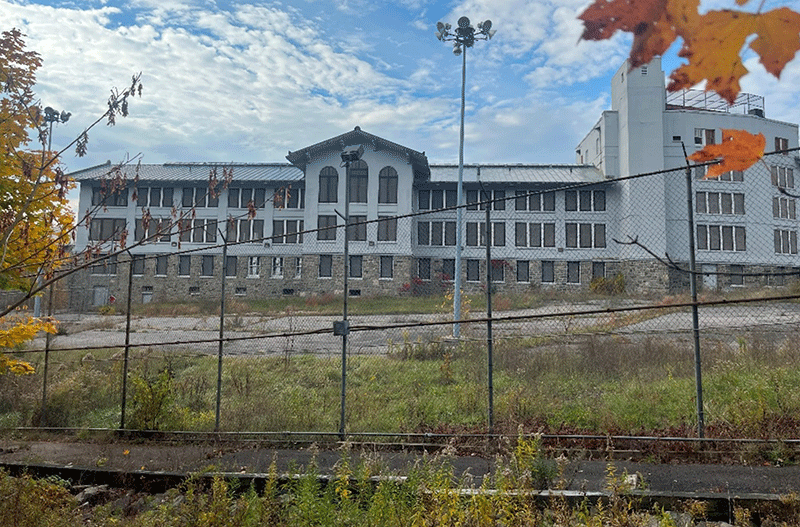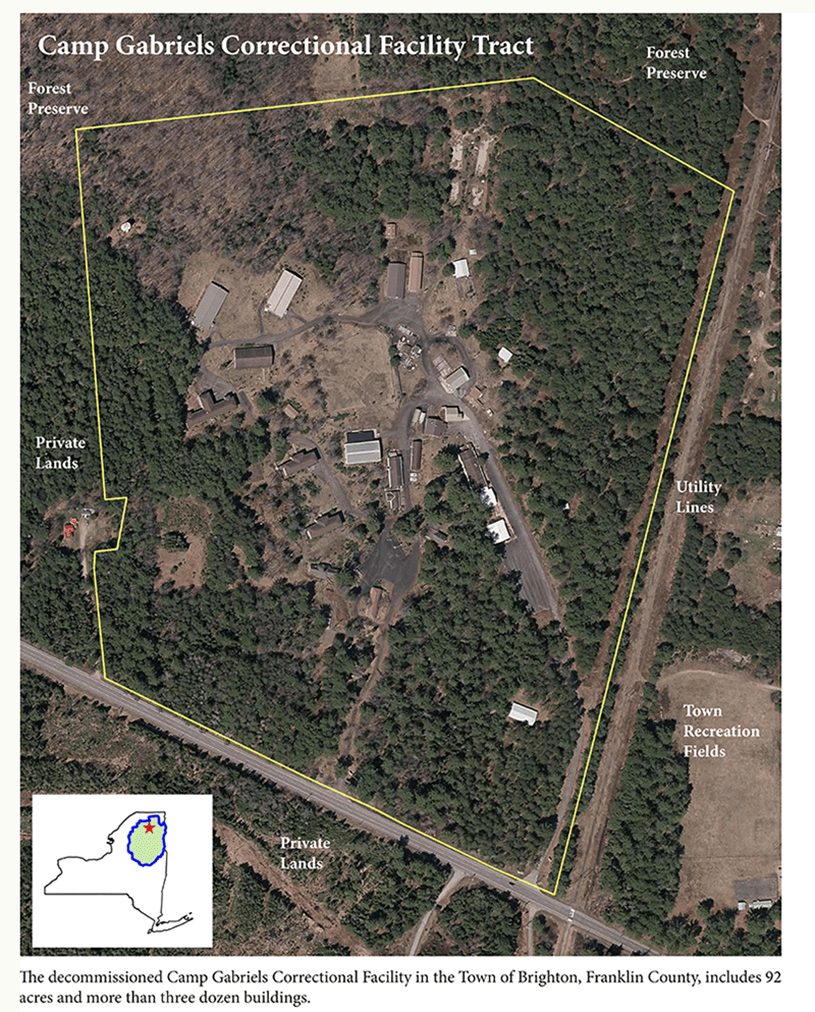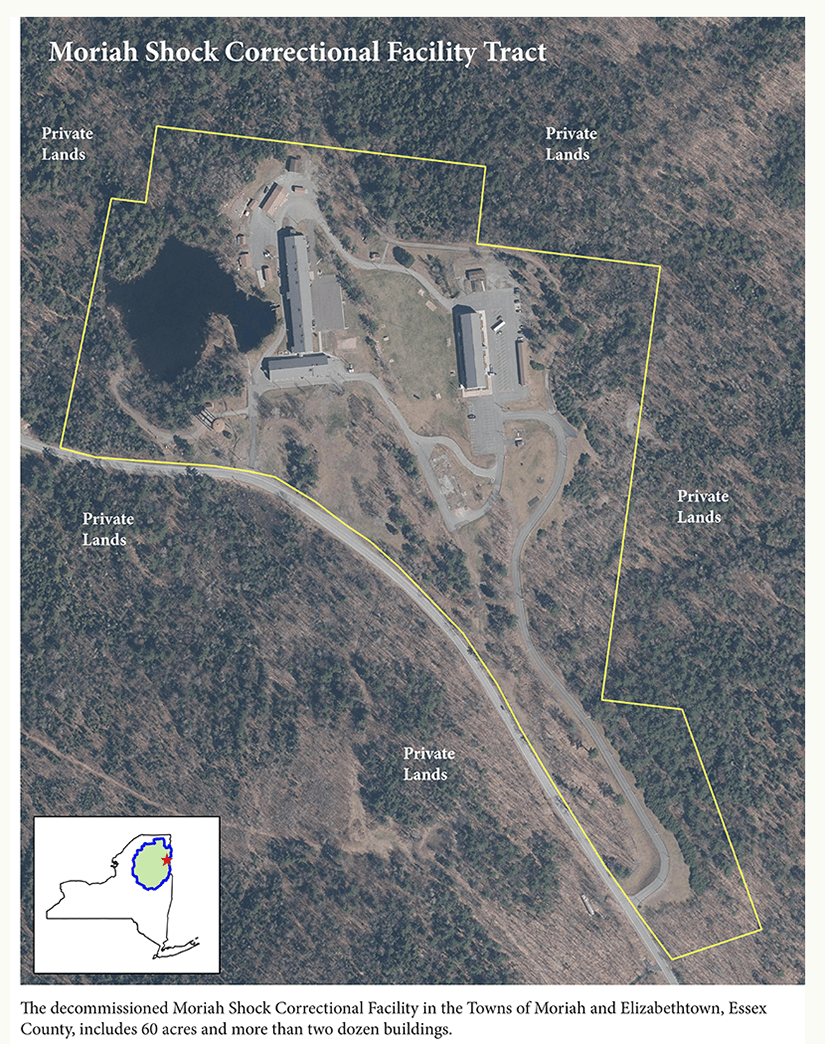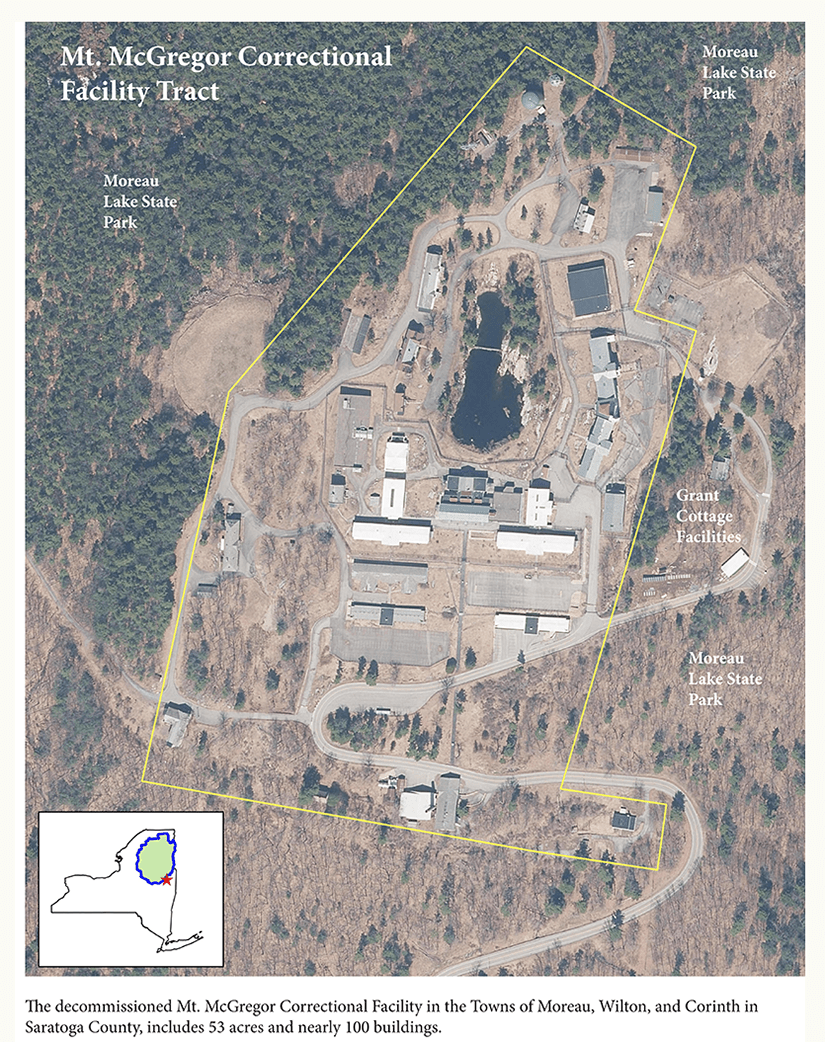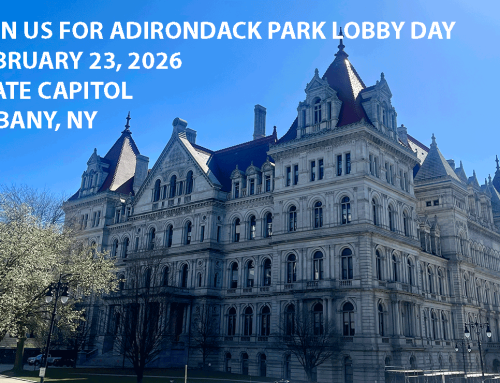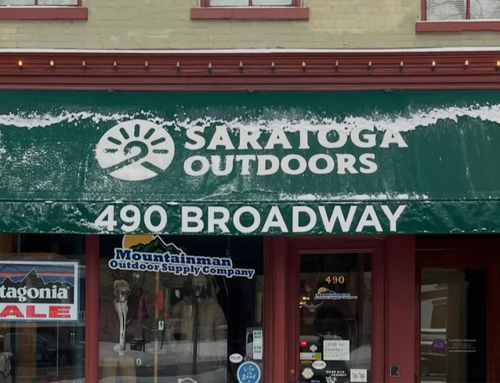The only way for these closed state prisons to be sold or transferred to private ownership is to first pass a Constitutional Amendment.
There are now three decommissioned State correctional facilities on Forest Preserve lands. Two are within the Adirondack Park and one is outside the Park on Forest Preserve lands in Saratoga County. The three closed prisons are Camp Gabriels Correctional Facility in the town of Brighton, Franklin County; Moriah Shock Incarceration Correctional Facility in the towns of Moriah and Elizabethtown, Essex County; and Mount McGregor Correctional Facility in the towns of Corinth, Moreau and Wilton, Saratoga County.
New York State’s prison population has shrunk to around 32,000 from a high of nearly 75,000 in 1999-2000. The reduction in inmates has led to the closing of more than two dozen prisons around the state. Camp Gabriels has been closed since 2009 and Mount McGregor since 2014, while Moriah Shock was shut down more recently in 2022. The State Police are temporarily using the Mount McGregor facility for training exercises, but this is short-term. As state prisons, none of these facilities pay local taxes, unlike the majority of the Forest Preserve where all local real property taxes for the lands are locally assessed and paid by the State.
The facilities could be demolished and removed by the Department of Corrections (DOC) to restore the sites to a wild forest setting, but that does not appear to be a realistic or responsible proposal for these facilities. The buildings at Moriah Shock are still in relatively good shape. Some of the dozens of buildings at Mount McGregor are massive structures made of stone and concrete. Some of the buildings at Camp Gabriels are historic structures. Demolishing the buildings would be expensive and create a tremendous amount of waste and wasted opportunity.
The facilities could be used by the State, but the State has found it challenging to repurpose closed prisons anywhere. For instance, the facilities could be taken over from DOC by the Department of Environmental Conservation (DEC), the Adirondack Park Agency or the Office of Parks, Recreation and Historic Preservation, or any other state agency, to be used in a way that is consistent with Forest Preserve restrictions, but neither Governor Hochul nor any other state agency has stepped forward with a plan for any of these sites.
The facilities could theoretically be conveyed to a private entity for redevelopment, but the State Constitution prohibits the leasing or sale of these facilities to a private entity without a constitutional amendment. More than a decade ago, the Office of General Services organized a series of public auctions for the Camp Gabriels facility, where the winning bid was eventually around $166,000, but the sale was never completed due to the legal requirement for a constitutional amendment to clear title to the property.
Each of the three facilities is sprawling and contains a considerable amount of acreage and an assortment of buildings. Camp Gabriels includes roughly 92 acres and 48 buildings. Moriah Shock covers 60 acres and has around 20 buildings. Mount McGregor covers 53 acres and has around 100 buildings and structures. Camp Gabriels and Mount McGregor are linked historically to other state lands. Camp Gabriels was originally part of a much larger purchase, but the prison complex was separated from other Forest Preserve lands, which will remain as Forest Preserve, including a portion of the shoreline of Church Pond. The Mount McGregor prison complex is located adjacent to historic sites and other state lands, such as the historic Grant Cottage, where President U.S. Grant wrote his famous memoir as he was dying of throat cancer, and beautiful Lake Bonita in Moreau Lake State Park. The Town of Brighton is interested in gaining access to the Camp Gabriels’ water system to create a new water district for local residences in the area around Route 86 where residential wells have been contaminated by road salt pollution.
Local community leaders would like the opportunity to work with the State to repurpose these facilities and bring them back onto the tax rolls if they can be successfully removed from the Forest Preserve through a constitutional amendment. If they are not removed from the Forest Preserve, then nothing will happen with them, and they will sit and deteriorate. Camp Gabriels has already experienced significant deterioration of the buildings in the more than a decade during which it has sat dormant. Local leaders talk about possibilities like community housing, makerspace, small manufacturing parks, non-profit office space, and educational facilities, among other things, although there are no specific proposals for any of the facilities.
Under state law, a constitutional amendment requires passage by two successive legislatures and approval by the voters in a general election. An amendment for the three facilities could obtain “First Passage” in 2024, and “Second Passage” in 2025 after the November 2024 legislative elections, and then be voted on by the public statewide in November 2025. Failure to act in 2024 will push the timetable back to 2027 at the earliest.
Protect the Adirondacks supports a Constitutional Amendment to Article 14, Section 1, the “Forever Wild” clause for all three facilities. Historically, Article 14 constitutional amendments are only pursued when they are needed to solve some kind of problem facing Adirondack communities or administration of the Forest Preserve. We believe that a Constitutional Amendment for the three facilities passes both tests for helping communities to provide municipal services, revitalize these sites, and to improve Forest Preserve management.
These fully developed sites could be repurposed somehow, either by one entity that purchases the facility, or by many entities, public and private, working together. The State could either sell or transfer them to local governments. While closed prisons do not have a strong track record of successful adaptive re-use in New York, the location of Mount McGregor in Saratoga County, long the fastest growing county in the state, and the good condition of all of the buildings at Moriah Shock, which functioned more like an educational campus, hold real possibilities. The location of Camp Gabriels in the Tri-Lakes area of the Adirondacks, arguably the most dynamic neighborhood in the Adirondack Park, also holds promise. In addition to meeting any number of public needs from housing to small business space to non-profit space, repurposing could bring these facilities back onto the tax rolls, which would benefit local governments and schools. The reality, though, is that nothing can happen without a constitutional amendment to free up these facilities for future public or private use.
An amendment would also remove scores of non-conforming buildings from the Forest Preserve and remove inconsistent, incongruent uses. Replacement lands to compensate the Forest Preserve should be part of the amendment, to be managed as new wildlands and provide public recreational and outdoor experiences. The existence of closed prisons on the Forest Preserve undermines very basic Forever Wild values of wilderness, solitude, outdoor recreation, wildlife protection, and universal openness and accessibility.
A 3 Prisons Constitutional Amendment is an investment in Adirondack communities and the Forest Preserve, and, really, what could be better than that?
Click here to read an op-ed in the Adirondack Daily Enterprise about the need for a 3 Prisons Amendment.

